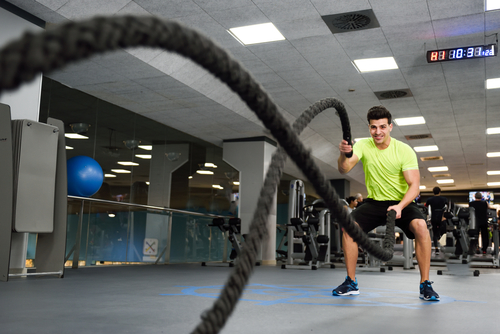Battle Rope Conditioning Workouts – The Complete Guide!
Battle ropes are a great bit of training kit for conditioning work. I use them every single week in my personal training sessions, but also for my own training. In this article we’re going to discuss everything there is to do with battle rope conditioning workouts.

What I like about battle ropes are their ease of use coupled with their versatility. From a personal training point of view, a battle rope allows you to perform a wide variety of high intensity exercises and workouts with people who have relatively little skill in the gym. Compare this for example to weight lifting, kettlebell or plyometrics where there is a skill and stability element to contend with.
Another benefit of battle rope conditioning workouts is that they are upper-body focussed.
The majority of conditioning workouts are lower-body centric, meaning they largely neglect the upper body from a conditioning perspective. You can achieve upper body conditioning by using high rep, low weight lifting exercises, but they aren’t as fluid in their movements as battle rope exercises.
Battle rope conditioning workouts are more dynamic than ‘traditional’ upper body exercises. When the focus is on performing a weight training movement, the benefit comes from the perfect execution of the exercise rather than the frequency of the repetitions or the pursuit of exercise until fatigue.
The lack of impact from battle rope exercises also means that they are ideal for someone who is returning to exercise post lower-body injury, or someone who is heavier, new to exercise and any unnecessary impact would be dangerous. It means we have options beyond bikes and rowers.
How to Structure Battle Rope Conditioning Workouts
A battle rope conditioning workout is like any other workout – you have a number of considerations to make when it comes to exercise selection, times and types. As with any other workout, the goal isn’t simply to get tired, it’s to get better!
Battle Rope Conditioning Workouts – The Exercises
Choosing battle rope conditioning exercises is the start of a workout. You have to consider a number of factors here, such as the client ability, the client goals, the goals of the workout, the available space, the time available etc.
Here’s a checklist I go through when choosing the exercises for battle rope conditioning workouts…
- Workout goal – is it a full workout, or just a finisher?
- Previous work – what has the client already done in the session?
- Client fitness level – how much can they cope with?
- Client goals – are they looking for conditioning or rehab for example?
- How much room do I have to work in?
- How much time do I have to work with?
These are just some of the considerations have you to make when you design battle rope conditioning workouts. If you think battle rope workouts are merely a question of performing rope slams until you vomit, you’re either a really bad trainer or don’t understand the role this kit can have in a training plan.

Battle Rope Conditioning Workouts – The Exercise Order
As with any workout, I like to go with most complex exercises down to least complex exercises. There are a few reasons why I go with this approach…
- The more complex exercises are more demanding both physically and neurally, so are best going first.
- It allows the complex exercises to be performed when you feel freshest.
- Complex exercises have more technical requirements, so benefit from a higher level of freshness.
- The easier exercises typically use smaller muscle groups, which are largely unaffected by the more complex, multi-joint exercises.
Battle Rope Conditioning Workouts – The Exercise Schedule
Once the order of exercises has been decided, I then decide on a time/rep schedule. These vary depending on the type of session, the client goals and the exercises I’ve included in the workout.
- Ascending/Descending pyramid – do the reps or time increase/decrease with each set?
- Time or rep based – are we going for a rep range or keep working until the clock stops?
- Are we resting between exercises? If so, how long?
- How demanding are the exercises – more demanding = fewer reps/less time.
- Do we include ‘fillers’ such as sprints between exercises or sets?
Identifying these first of all will make your battle rope conditioning workouts effective, rather than just hard. There’s a big difference between the two. Any idiot can bring about fatigue, but it doesn’t necessarily move the client closer to their health and fitness goals. You need to think smarter to help them get there.
Example Battle Rope Conditioning Workouts
In this section I’m going to outline a couple of example battle rope conditioning workouts and how I would structure them. In this case I’m assuming the client is injury free, relatively fresh and the workout goal is conditioning….
Battle Rope Conditioning Workout 1
Take each exercise and perform it for 30 seconds. Do each exercise one after the other without rest. Once you’ve done 30 seconds of all 5 exercises, rest for two minutes.
Repeat x 5
Battle Rope Conditioning Workout 1
Battle Rope Conditioning Workout 2
This is a workout I’d use as a ‘finisher’ – an intense end to a session designed to raise the heart rate and spike calorie burning at the end of a session. Finishers are typically shorter, contain fewer exercises and shorter rests (if any), because the workout is designed to be short and intense.
In this workout I’d perform 20 reps of each exercise, rest as little as possible, then perform 18 reps, rest as little as possible, 16 reps and so on, right down to 2 reps.
Aim to do the workout in the shortest time possible.
Battle Rope Conditioning Workout 2
Where Can I Buy Battle Ropes?
There are lots of places to pick up battle ropes online, but I’ll give you a word of warning – you can be seriously over-charged if you go through a fitness provider who deals in general equipment. The guys over at www.buyrope.co.uk have fantastic ropes at really great prices – better than any I’ve seen online.
Not only are their prices better (as they are a specialist rope retailer), but they also offer a much wider variety of battle rope options, so you can buy different ropes to suit your needs.
Battle Rope Conditioning Workouts – Concluded
You may have seen battle ropes in the gym and not used them – either because you didn’t think they were much use or because you didn’t really know what to do with them. Hopefully after reading this blog post you’ve changed your mind and will make battle rope conditioning workouts a part of your training!
You’ll be glad you did – so will your body!

One thought on “Battle Rope Conditioning Workouts – The Complete Guide!”